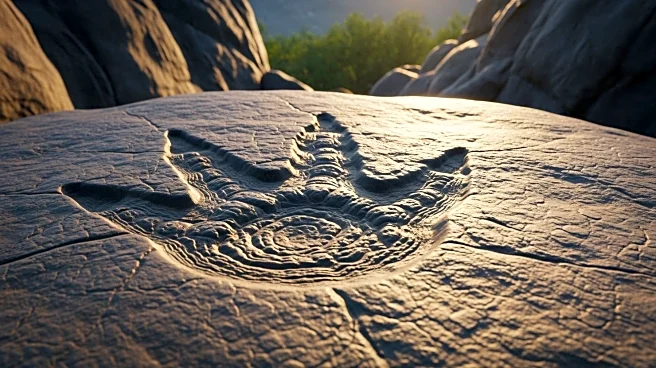What's Happening?
A team of paleontologists has identified a new genus and species of theropod dinosaur, named Anteavis crurilongus, in the Ischigualasto Formation in northwest Argentina. This discovery was made by researchers
from the Universidad Nacional de San Juan, Museo Argentino de Ciencias Naturales ‘Bernardino Rivadavia,’ University of Birmingham, CONICET, and CIGEOBIO. Anteavis crurilongus lived during the Carnian age of the Late Triassic epoch, approximately 231 to 226 million years ago. The dinosaur measured about 1.2 meters in length and weighed between 8-9 kilograms. It is considered one of the oldest and most primitive dinosaurs known, with features previously thought to be exclusive to the Neotheropoda group. The fossilized remains, including a partial skeleton and skull, were unearthed in 2014. The discovery highlights the early diversification of dinosaurs, which led to significant ecological changes in terrestrial ecosystems.
Why It's Important?
The identification of Anteavis crurilongus provides crucial insights into the early diversification of dinosaurs, a period that significantly altered terrestrial ecosystems. This diversification eventually led to dinosaurs dominating tetrapod assemblages by the Triassic/Jurassic boundary. Understanding this initial diversification is essential for comprehending the establishment of Mesozoic assemblages. The discovery also emphasizes the importance of the Ischigualasto Formation as a site for well-preserved ancient fossils, offering valuable data for paleontological research. The findings suggest that dinosaur diversity and abundance in the region were higher than previously recognized, particularly among small herbivores and medium-sized predators.
What's Next?
The research team plans to continue studying the Ischigualasto Formation to uncover more about the climatic shifts and faunal turnovers that occurred during the Triassic period. Further exploration may reveal additional species and provide deeper insights into the climatic conditions that influenced dinosaur evolution. The findings could also lead to a better understanding of how climate-driven changes impacted faunal diversity and distribution in prehistoric ecosystems.
Beyond the Headlines
The discovery of Anteavis crurilongus underscores the role of climate in driving faunal turnover and diversification. The climatic shift to semi-arid conditions in the Ischigualasto Formation likely contributed to the diversification of dinosaurs. This research highlights the complex interplay between climate and evolutionary processes, offering a window into how ancient ecosystems responded to environmental changes.













